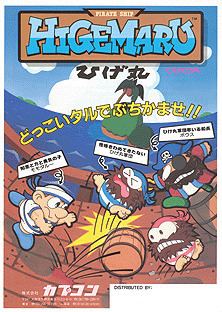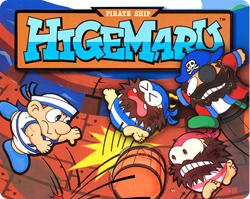Composer(s) Tamayo Kawamoto Publisher Capcom | Initial release date September 1984 | |
 | ||
Mode(s) Single player, 2 player alternating Similar | ||
Pirate Ship Higemaru (Japanese: ひげ丸) is a maze video game by Capcom originally released in 1984 as a coin-operated arcade game. The gameplay is similar to that of the 1982 Sega arcade game Pengo, but with the arctic theme replaced with that of a pirate ship.
Contents
The game was later included in the 1998 compilation Capcom Generations: The First Generation for the PlayStation (in Japan and Europe) and Sega Saturn (Japan only). Like the other games in the Capcom Generations titles, it was included in the 2005 compilation Capcom Classics Collection for the PlayStation 2 and Xbox, and in the PlayStation Portable version Capcom Classics Collection: Reloaded, which was the first time the game was released for home consoles in North America.
Mamecade 42 pirate ship higemaru mame arcade game
Gameplay
The player controls a Norwegian sailor by the name of Momotaro, who must use barrels to defeat the titular pirate crew. Momotaro has no attacks of his own. However, he has the ability to grab barrels, drums, large bags, and various other items which he can throw (either horizontally or vertically) across the screen. Any pirate who stands in the way of a barrel or other object will be hurled off the screen. Barrels that impact the walls of a stage or other barrels or objects will shatter and produce points, while other objects are invulnerable (but do not produce points). Each successive enemy that is hit by a barrel will yield additional points once the barrel is destroyed. In addition, there are also various items hidden beneath barrels in each level which will give Momotaro bonus points. Every floor of the ship has a set number of pirates to be destroyed, as well as a single "Bow", a special pirate that regenerates each time it is defeated. Every fourth level in the game yields a bonus level in which the barrels are worth an increased number of points, and a group of enemies entirely made up of Bows (which do not regenerate in this case). With each successive floor, the speed and intelligence of the pirates increases. For every sixteen barrels Momotaro destroys, he will be rewarded with an item that grants invincibility for a limited amount of time, allowing him to defeat enemies by simply touching them. Momotaro's enemies do not have attacks, but a single touch from an enemy will cause him to die and be revived, costing the player one of his/her extra lives; the game will be over when he or she has no more lives. The game has no ending, but following the sixteenth level, the enemy patterns will reset to level one. The layout of the barrels on the stages will continue to change, however, and the enemy count per level will not reset to level one counts. Following level 16, the game may Kill screen at the start of a level or after losing a life.
Characters

